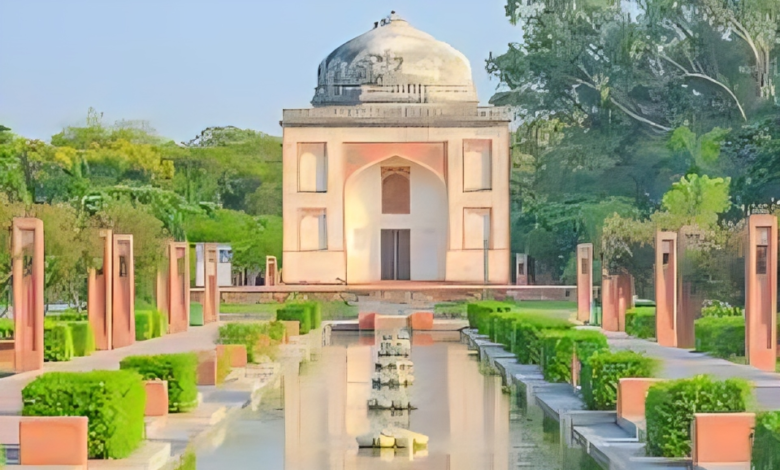Sunder Nursery A Historic Gem of Delhi’s Green Heritage

Sunder Nursery, often referred to as the ‘green lung’ of New Delhi, is a vast, historic, and well-preserved urban park that serves as a refreshing escape from the hustle and bustle of the city. Nestled close to the iconic Humayun’s Tomb, this sprawling garden offers a perfect blend of nature, history, and culture. Whether you’re a history enthusiast, a nature lover, or simply someone seeking a peaceful retreat, Sunder Nursery has something to offer.
In this article, we will explore the history, significance, flora, fauna, restoration efforts, and visitor experiences at Sunder Nursery. By the end of this guide, you’ll have a deeper appreciation of why this hidden gem is worth your time.
A Glimpse into History
Sunder Nursery’s roots can be traced back to the Mughal era. Originally a part of the Mughal garden landscape, it was created as a royal nursery where plants were cultivated for the royal gardens of the Mughal emperors. In the 16th century, the Mughal rulers were known for their expertise in garden design and horticulture. The nursery’s role was to grow plants that would later be used in the construction of gardens and buildings throughout the empire, including the famous gardens of Humayun’s Tomb.
After the Mughal period, the area gradually fell into neglect. However, it was only in recent years that Sunder Nursery underwent significant restoration and revitalization to become the lush, well-maintained park that it is today.
The Restoration of Sunder Nursery
The restoration of Sunder Nursery began in 2016 as part of a larger initiative to rejuvenate Delhi’s historic gardens. The project was spearheaded by the Aga Khan Trust for Culture (AKTC) in partnership with the Archaeological Survey of India (ASI) and the Delhi Development Authority (DDA). The restoration aimed to revive the green space while preserving its historical essence.
The project focused on both the ecological and architectural aspects of the park. Large-scale efforts were made to restore and enhance the landscape, including the construction of pathways, installation of modern facilities, and preservation of the historical monuments scattered throughout the site. Sunder Nursery now stands as a shining example of sustainable urban park design that preserves both heritage and nature.
Monuments and Heritage Structures
One of the key highlights of Sunder Nursery is the collection of heritage structures scattered throughout the grounds. These include Mughal-era tombs, gateways, and wells, each holding significant cultural and architectural value. Among the most notable monuments is the Sunder Burj, a charming Mughal structure that adds a sense of grandeur to the surrounding greenery.
Other prominent structures include the tomb of Isa Khan, an Afghan noble in the service of Sher Shah Suri, who is believed to have played a vital role during the Suri Empire. The tomb is intricately designed with stone carvings, decorative motifs, and is surrounded by lush gardens, offering a glimpse into the past while blending seamlessly with the landscape.
The architectural designs of these tombs and structures are remarkable, reflecting the Mughal design principles of symmetry, geometric patterns, and a connection between nature and built form. These structures, along with the rich flora and fauna of the park, create an atmosphere of peace and tranquility.
Flora and Fauna
Sunder Nursery is not only an oasis of history but also an ecological sanctuary. The park is home to over 300 species of trees, plants, and shrubs, many of which are indigenous to the Indian subcontinent. Visitors can witness an impressive variety of flora ranging from tall, shady trees to vibrant flowers and aromatic plants.
One of the major ecological features of the park is the collection of heritage trees that have been carefully preserved and nurtured. The efforts to restore the park’s flora are part of the broader ecological vision that includes creating a habitat for diverse plant and animal life. The nursery has become an important space for urban biodiversity conservation.
The park is also home to a variety of bird species, including common mynas, koel birds, and various migratory birds during certain seasons. Visitors can often spot birds perched on trees, darting across the sky, or bathing in the park’s many fountains and ponds. It’s a perfect spot for birdwatching and nature photography.
In addition, Sunder Nursery is home to a few species of butterflies and insects, further enriching its biodiversity. The combination of historical monuments, diverse plant life, and local fauna makes Sunder Nursery a one-of-a-kind place where visitors can engage in both leisure and learning.
Activities and Attractions
Sunder Nursery offers a wide range of activities for its visitors. Whether you’re an avid photographer, a history buff, or someone simply looking to relax, the park has it all. Some of the activities and attractions include:
- Walking Tours: The lush lawns and scenic pathways make Sunder Nursery a great place for leisurely walks. Visitors can explore the park at their own pace, enjoying the calm atmosphere and admiring the unique mix of historical and natural beauty. Guided walking tours are also available for those interested in learning more about the history and significance of the various monuments and gardens.
- Photography: For photography enthusiasts, Sunder Nursery is an absolute treasure trove. The mix of architectural heritage and lush greenery makes for incredible photo opportunities. The natural light, combined with the park’s serene environment, offers a picturesque setting for landscape, architecture, and wildlife photography.
- Picnics: Families and groups of friends often gather for picnics in the shaded areas of the park, especially around the ponds and flowering plants. The atmosphere is ideal for a quiet day out with nature, away from the constant noise of the city.
- Heritage Gardens: The nursery also features themed gardens, such as the Mughal-style water gardens and a variety of flowering plants. These gardens have been meticulously designed to reflect Mughal horticultural practices, offering a sense of timeless beauty.
- Birdwatching: As mentioned, Sunder Nursery is a haven for birds. Early mornings and evenings are the best times to spot various bird species. The peaceful environment and lack of heavy traffic make it an ideal birdwatching location.
- Workshops and Educational Programs: Sunder Nursery regularly hosts workshops on gardening, eco-friendly practices, and heritage conservation. These programs are designed to educate visitors about the importance of preserving natural spaces and cultural heritage.
Visitor Experience
Sunder Nursery has become a popular destination for both locals and tourists. Its serene environment offers a peaceful retreat in the heart of one of the world’s busiest cities. Visitors can enjoy the park for free, making it an accessible destination for everyone.
The park’s layout and infrastructure are designed to be visitor-friendly. There are clean restrooms, benches for resting, and ample spaces to sit and enjoy the surroundings. The staff at the park are knowledgeable and friendly, always ready to assist with any queries about the park’s history or facilities.
For those looking to enjoy a quick bite or refreshments, the park has a small café serving snacks and beverages. The café’s outdoor seating area offers a beautiful view of the surrounding greenery, making it a pleasant spot to relax.
Conclusion
Sunder Nursery is much more than just a garden; it’s a testament to the enduring legacy of Delhi’s historical and ecological heritage. With its carefully restored monuments, lush greenery, and diverse flora and fauna, the park offers a tranquil space where nature and history coexist harmoniously.
For anyone visiting Delhi, whether for a day or a few hours, Sunder Nursery is an essential destination. It’s an invitation to step back in time, breathe in fresh air, and reconnect with nature. The restoration efforts have ensured that this green oasis remains preserved for future generations to enjoy, making it one of Delhi’s hidden treasures.




